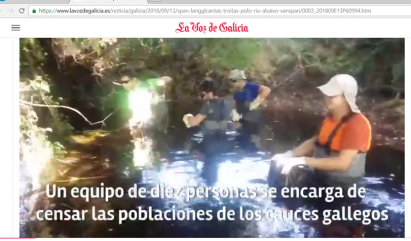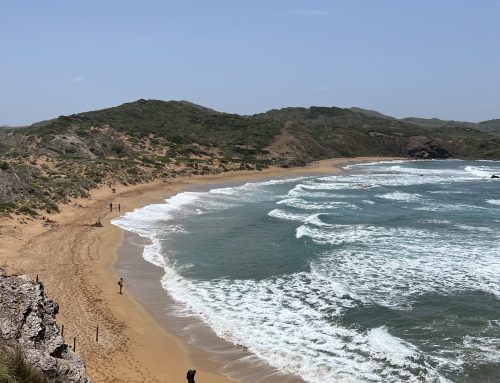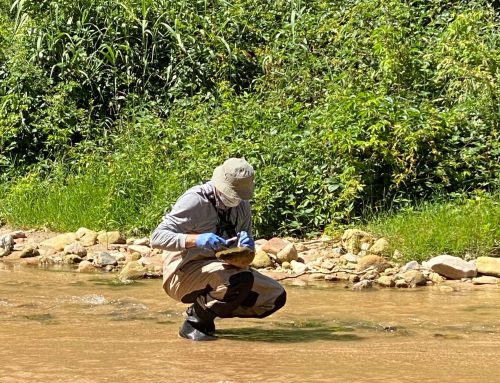A mixed team of ten people from Dnota Medio Ambiente is in charge of censusing the populations of Galician watercourses “Article published in La Voz de Galicia”.
Hulius -with an aspirated h- lives in Galicia, as do Antonio and Irene. All of them are inhabitants of the Galician rivers, a population that during the last months have been censusing technicians of the company Dnota Medio Ambiente, with delegation in Cambre, to which the Dirección Xeral de Patrimonio Natural has commissioned the count of the fish species of the river beds of the community and, incidentally, the characterization of its waters and the environment. The team -Aitor, Alfonso, Elisa, Fernando, Irene, Jesús, Jorge, Julio, Quique and Rubén, divided into two groups of five- has waded the Miño and the Sil, but also the Eume, the Támoga, the Mandeo… In total, 124 rivers (72 in the northern area and 52 in the south).
As the work was nearing completion, the Grouper River was touched again on Monday. This time in a stretch where it is difficult to know if you are in Betanzos or in Abegondo, above the Cecebre reservoir. There, in an environment dominated by ameneiros, salgueiros, ash trees and a tall ventureira hops plant, the technicians are engaged in the same routine that they have previously applied in 280 other locations. The first thing to do is to delimit the work area. Nets arranged upstream and downstream mark the area to be explored. And then to look for fish. Perhaps more than one will be surprised to learn that electricity is used to capture them. Yes, the controversial electric fishing, authorized for this purpose, which is not precisely to fill the trout basket, but to know the abundance, variety and health of the Galician ichthyological resources. “It is a technique that does nothing to the fish, it only attracts them to the current,” says Mario Gómez, area director of Dnota.
At the head of the expedition, a team member carries a ten-kilogram backpack that holds an electric generator. This allows him, at the click of a button on a pole, to hypnotize the inhabitants of the place towards that sort of metallic halo that crowns the contraption. Those who enter, temporarily move to the trueles, which are carried behind by two other technicians, and then settle on a rejon carried by a fourth person. The last one in the row takes data on the bottom – if there is rock, if there is sand, if there is shale… -, on the water – oxygen, temperature, PH… -, aquatic and terrestrial vegetation, hydrology… Thus, zigzagging the entire course, they empty the river of its inhabitants.
And how do you get them to stand still to census them? “They are introduced in water with cloves”. No, not metal. It is a plant with a known anesthetic effect that relaxes and calms the individual while the team measures and weighs the specimens one by one. Eventually they return to the riverbed, where they regain consciousness and continue their daily lives.
Trout and fish in the Grouper
On Monday in El Mero they counted 87 inhabitants. All trout and sea trout -they doubted if it was a salmon, but it was a trout that wanted to make a splash-. And none of an entity that deserved a name of its own, because the team distinguishes the most distinguished inhabitants. “We name the specimens that exceed 50 centimeters,” says Aitor. It was he who baptized Hulio, a 66-centimeter specimen of trout – “a trout”, he says – which they found in a tributary of the Neira that they prefer not to specify so as not to give clues to poachers. That there are, there are some. And with those who have sometimes confused them.
Good fishing? “Razoablemente boa,” says Gómez, who, however, emphasizes that the data, thus, isolated, do not mean anything. “Ata que non se procesen non se pode concluír nada”. And that is something that is up to the Xunta: to know how many trout “polo río abaixo van”.

https://www.lavozdegalicia.es/noticia/galicia/2018/09/13/span-langglcantas-troitas-polo-rio-abaixo-vanspan/0003_201809E13P60994.htm



